|
-
 Tire wear bar question Tire wear bar question
Once you get to these wear bars the tire seems only half worn. Should the tire be replaced? Seems pre mature
-
SpyderLovers Sponsor
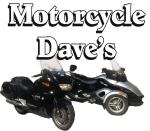
 Tires Tires
Go to your local auto zone or other auto
parts store and buy a tread depth gauge,
most all tires except truck tires start out
with 11/32 to 13/32 tread depth when new
the wear bars are molded in the tire to be
visible at 2/32.
You must be the judge I personally would
replace any tire with the wear bars showing.
Tires and brakes are the cheapest insurance
you can buy.
Dave
 Originally Posted by Zummyannie

Once you get to these wear bars the tire seems only half worn. Should the tire be replaced? Seems pre mature
-
Very Active Member
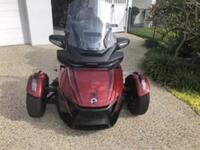
 Looking in the right spot? Looking in the right spot?
Harrington, Australia
2021 RT Limited
Setup for Tall & Big.... 200cm/6'7", 140kg/300lbs, 37"inleg.
HeliBars Handlebars
Brake rubber removed to lower pedal for easier long leg/Size 15 EEEEW boot access.
Ikon (Aussie) shocks all round.
Russell Daylong seat 2” taller than stock (in Sunbrella for Aussie heat & water resistance)
Goodyear Duragrip 165/60 fronts (18psi) - provides extra 1/2” ground clearance.
Kenda Kanine rear.
2021 RT Limited , Brake pedal rubber removed for ease of accessing pedal with size 15 boots. Red
-
Very Active Member

 Little checking.. Little checking..
20160504_090715.jpg this is the wear bar check point. there are other bars for rain etc. find the triangle and straight across you will find the wear bars. 
But just so you know when you get to the wear bar your tire may look like this...20160324_085157.jpg ...
Gene and Ilana De Laney
Mt. Helix, California
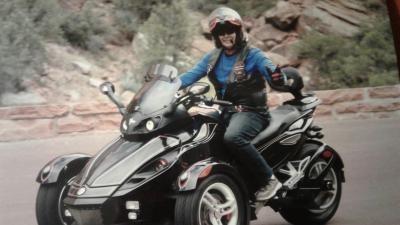 2012 RS sm5
2012 RS sm5
2012 RS sm5 , 998cc V-Twin 106hp DIY brake and park brake Classic Black
-
Very Active Member
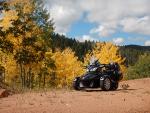
 But as others have mentioned-- make sure you are looking at the REAL WEAR BARs But as others have mentioned-- make sure you are looking at the REAL WEAR BARs
Most tires including the Kendas have a small triangle on the edge of the tread to indicate the REAL WEAR BARS. Kenda seems to like to put higher "water breaker bars" in that get a lot of tires swapped out early.... Your call, but here in the arid West, I run them down to the REAL WEAR BARs.DSCN1579.jpgDSCN1592.jpg
-
Very Active Member
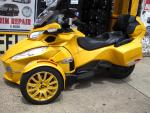

most tires are 10/32" new, tires for the most part should be replaced when they reach 4 & for any type of wet traction
that is their limit. below 4/32" dry pavement only & a tack can punture it.
-
Very Active Member


I usually do not run tires that low. If you aren't comfortable with the tread you have left, change the tire. Peace of mind is important when riding.
2016 F3 Limited
2019 Ryker Rally
2014 Suzuki V Strom 650
2020 CSC TT 250
-

 Originally Posted by Highwayman2013

I usually do not run tires that low. If you aren't comfortable with the tread you have left, change the tire. Peace of mind is important when riding.
Also, I've read that 90% of punctures happen during the last 10% of a tire's legal tread life.(sounds reasonable to me)
2015 F3 (wife's)
2014 Indian Vintage
2019 AMG C43 cabrio
1966 LS1 Corvette restomod
1956 Corvette survivor (wife's)
1941 Chevy hotrod truck
2023 Corvette Z06
-
Very Active Member

 Ticket Ticket
Check your local traffic laws. In some states if you are worn to the wear bars (2/32"), it's Ticket Time.
2011 RTS (Sold to a very nice lady)
1998 Honda Valkyrie
2006 Mustang GT. Varooooom!
US Navy Veteran
SC Law Enforcement Boat Captain
CNC Machine Service Technician
President: Rolling Thunder SC1
Member: Disabled American Veterans, Rock Hill, SC
Member: American Legion
Experience is recognizing the same mistake every time you make it!  
-

 Originally Posted by petegtsv10

Also, I've read that 90% of punctures happen during the last 10% of a tire's legal tread life.(sounds reasonable to me)
I must be in the 10%. Twice I've gotten punctures in nearly brand new motorcycle tires. 
When life throws you curves, aim for the apex
Current stable: 09 Thruxton / 09 FZ6
Sold List: 97 Ninja500R, 03 SV650K3, 01 Ducati 750Sport Dark, 73 CB350/4, 03 F650GSA, 08 Gixxer600, 03 Gixxer600, 91 VFR750F, 09 KLX250, 06 Thruxton 900, 08 Spyder RS , 12 Street TripleR, 15 RC390, 02 VFR800, 09 KLX250S, 10 F650GS
JLohPhotos
... Motorcycles are kind of like Baskin Robbins... You're looking at 31 flavors of ice cream, don't you kind of want to know what they all taste like?...

-
Ozzie Ozzie Ozzie
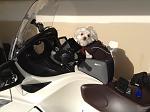
-

 Originally Posted by Peter Aawen

That can be due to running your tire pressures too high; or using too much throttle on take off in the loose stuff!! 
Pump your tires up too much & the tread cant 'flex or fold' at all if it hits an obstacle or debris on the road like it needs to in order to conform over stuff instead of impaling it straight thru the tread!! As for the spinning tire thing, those events are usually obvious & your choice! 
Whatever the reason for it happening, getting punctures in a new tire are a right pain!! 
I'm fastidious about my tire pressures on the bikes. It was a construction staple once and a screw another. Also having soft sport compound rubber doesn't help.
When life throws you curves, aim for the apex
Current stable: 09 Thruxton / 09 FZ6
Sold List: 97 Ninja500R, 03 SV650K3, 01 Ducati 750Sport Dark, 73 CB350/4, 03 F650GSA, 08 Gixxer600, 03 Gixxer600, 91 VFR750F, 09 KLX250, 06 Thruxton 900, 08 Spyder RS , 12 Street TripleR, 15 RC390, 02 VFR800, 09 KLX250S, 10 F650GS
JLohPhotos
... Motorcycles are kind of like Baskin Robbins... You're looking at 31 flavors of ice cream, don't you kind of want to know what they all taste like?...

-
Ozzie Ozzie Ozzie


 Originally Posted by asp125

I'm fastidious about my tire pressures on the bikes.....
Ahh, but WHAT pressures are you being fastidious about running?? 
The bike manufacturers 'sell a lot of bikes' recommendation for the stock tire, or the tire manufacturers recommendation for the load which that particular bike & you/the rider place upon the tires you have fitted to the bike??
You are absolutely right about the soft compound sport tire not helping, & maybe those particular punctures weren't contributed to by compromising tire pressures, but even the softest of compound tires will be way more likely to resist puncturing by a screw or construction staple IF it is being run at the correct pressure for that tire under the load currently being imposed upon it rather than it will if it's blown up to a pressure intended to help the bike manufacturer make lots of sales..... 
Tires inflated too much will work just like a balloon that's been blown up close to its maximum - the balloon inflated to its maximum certainly looks good, bounces around well, but pretty much touch it with anything that's the slightest bit sharp & it punctures & bursts!! Heck, a balloon blown up hard enough can even be burst by gently landing on a soft green lawn!! Same balloon, blown up 'not quite so hard' might look slightly smaller, bounce around not quite so well (but it'll be very close) and yet it'll be waaayyyy more resistant to puncturing by anything!! The first, you can often burst just by poking it with a blunt finger (or letting it touch a soft blade of grass!) the second will just conform over a poking finger (or a spiky blade of grass) because it isn't pumped up so hard & therefore has a little more scope for flexing & wrapping over/around an obstacle that the first just doesn't have!!  Then just for a giggle, try pressing the first balloon gently against a pane of glass & sliding it along the pane?? Generally, it'll be easy enough to do.... But do that with the second balloon, pressing it in with the same force & then trying to slide it along the glass.... almost always, you'll find it just ain't gonna happen cos the 2nd balloon conforms more to the pane of glass & has a whole lot more traction upon it!! I wonder, will that help when applied to bike tires?!? Then just for a giggle, try pressing the first balloon gently against a pane of glass & sliding it along the pane?? Generally, it'll be easy enough to do.... But do that with the second balloon, pressing it in with the same force & then trying to slide it along the glass.... almost always, you'll find it just ain't gonna happen cos the 2nd balloon conforms more to the pane of glass & has a whole lot more traction upon it!! I wonder, will that help when applied to bike tires?!?
Yep, it will! But you will need to know the use & load you are placing on the particular tires you are running and check that Tire Manufacturers recommended inflation specs for the use & load you are placing upon them, instead of just taking the bike manufacturers recommendation that's somehow meant to work for any tire as well as anyone/everyone in all circumstances & carrying any load placed upon it.... 
Last edited by Peter Aawen; 12-05-2016 at 04:45 PM.
-
Very Active Member

-
Very Active Member


Save your money and use a copper USA penny.
If the tread is giving Abe a haircut time for a change 
AJ
 Originally Posted by Motorcycledave

Go to your local auto zone or other auto
parts store and buy a tread depth gauge,
most all tires except truck tires start out
with 11/32 to 13/32 tread depth when new
the wear bars are molded in the tire to be
visible at 2/32.
You must be the judge I personally would
replace any tire with the wear bars showing.
Tires and brakes are the cheapest insurance
you can buy.
Dave

2014 RT-S
Akrapovic Exhaust & Cat Bypass
Bajaron Sway Bar w/links / Sena SM-10/Garmin 660
Comfort Seat w Adjustable Backrest
Decals by Purple Harley / Magic Strobe
Kuryakyn Black Widow Pegs Rivco Highway Brackets
Rivco Trunk Mounted Double Flag Holder
FOBO / Spyder Cuff / XM Radio w MC Antenna
-

 Originally Posted by Peter Aawen

Ahh, but WHAT pressures are you being fastidious about running?? 
The bike manufacturers 'sell a lot of bikes' recommendation for the stock tire, or the tire manufacturers recommendation for the load which that particular bike & you/the rider place upon the tires you have fitted to the bike??
You are absolutely right about the soft compound sport tire not helping, & maybe those particular punctures weren't contributed to by compromising tire pressures, but even the softest of compound tires will be way more likely to resist puncturing by a screw or construction staple IF it is being run at the correct pressure for that tire under the load currently being imposed upon it rather than it will if it's blown up to a pressure intended to help the bike manufacturer make lots of sales..... 
Tires inflated too much will work just like a balloon that's been blown up close to its maximum - the balloon inflated to its maximum certainly looks good, bounces around well, but pretty much touch it with anything that's the slightest bit sharp & it punctures & bursts!! Heck, a balloon blown up hard enough can even be burst by gently landing on a soft green lawn!! Same balloon, blown up 'not quite so hard' might look slightly smaller, bounce around not quite so well (but it'll be very close) and yet it'll be waaayyyy more resistant to puncturing by anything!! The first, you can often burst just by poking it with a blunt finger (or letting it touch a soft blade of grass!) the second will just conform over a poking finger (or a spiky blade of grass) because it isn't pumped up so hard & therefore has a little more scope for flexing & wrapping over/around an obstacle that the first just doesn't have!!  Then just for a giggle, try pressing the first balloon gently against a pane of glass & sliding it along the pane?? Generally, it'll be easy enough to do.... But do that with the second balloon, pressing it in with the same force & then trying to slide it along the glass.... almost always, you'll find it just ain't gonna happen cos the 2nd balloon conforms more to the pane of glass & has a whole lot more traction upon it!! I wonder, will that help when applied to bike tires?!?
Yep, it will! But you will need to know the use & load you are placing on the particular tires you are running and check that Tire Manufacturers recommended inflation specs for the use & load you are placing upon them, instead of just taking the bike manufacturers recommendation that's somehow meant to work for any tire as well as anyone/everyone in all circumstances & carrying any load placed upon it.... 
I reread your post looking for a statement I could agree with and there wasn’t one. The idea that a manufacturer recommends pressures to sell more tires is odd, at best. Never go by the tire specs as they do not take into account the complicated interface of your particular suspension. (shocks, springs , swaybars and front to rear weight balance) There is much more to optimal psi than the load on a tire!! My wife’s car has a near 50/50 weight balance and the manufacturer calls for 33 psi front and 41 psi rear to properly work with her car. My car (approx. same overall weight) calls for 30 psi all around. Both are high perf cars whose manufacturers are looking for every bit of perf bragging rights they can achieve. The vehicle manufacturer takes all of that into account as they test the vehicle during the design process.
The balloon analogy is absurd. Tires resist punctures and have optimal traction when properly inflated, not under-inflated. (cornering traction, not just straightline) Under-inflated tires generate more heat and wear faster, too. Puncture resistance is also better with proper inflation as that quality is more a function of the tires overall construction than just the tread. (i.e. the belts, etc.)
I’m not even sure that soft compound tires flat more easily. Generally, a soft compound tire is a higher perf tire and will have a more robust carcass. I’d wonder if the stronger, thicker belts outweigh the softer tread when it comes to flats.
2015 F3 (wife's)
2014 Indian Vintage
2019 AMG C43 cabrio
1966 LS1 Corvette restomod
1956 Corvette survivor (wife's)
1941 Chevy hotrod truck
2023 Corvette Z06
-
Ozzie Ozzie Ozzie


Some of what you say petegtsv may have merit, but (as I hope most realised) I was trying to highlight that using the CORRECT pressures for your TIRES rather than just sticking blindly to the 'compromise for all potential owners/conditions' pressure from the vehicle manufacturers & that potentially over inflating your tires can result in them being more puncture prone - the over inflated balloon vs a properly inflated balloon is a perfect example of what actually does occur when an over inflated tire vs a properly inflated tire hits a road obstacle..... 
But I must ask - surely you don't believe that the placard recommended pressure is absolutely 'correct' for all the potential conditions, road surfaces, drivers & driving styles, etc, which could well vary the loads & demands that the vehicle & its tires may be subjected to; and surely you do realise that there can be a fairly significant range in all those things that might just warrant maybe a little variation in the 'ideal' or 'correct' pressure for the tires rather than blind adherence to the vehicle manufacturer's provided 'Here's a 'one size fits all' tire pressure that'll be ideal for all of you drivers out there regardless of how hot or cold it is where you drive; regardless of how heavily or lightly loaded you might be running your vehicle right now; regardless of how fast or slow you might like to drive; regardless of how 'direct' or 'smooth' you like your steering response, or how 'soft' or 'firm' you like your ride; and regardless of all those other things that might vary from circumstance to circumstance & driver to driver'?!? The manufacturers pressure recommendation can at best only be a compromise considering the vast potential in the loads & driving demands they expect drivers to place upon that vehicle; sure, maybe an educated guess, but it's still just a compromise that they believe should work 'sorta OK' in most of the circumstances & under most of the conditions & loads that drivers might place upon the vehicle & its tires!
Besides, I wonder if you have any idea of how different the OE tire on just about any passenger or recreational vehicle when it leaves the factory actually is when compared to just about any replacement tire - & that often includes how different the OE tire that the vehicle rolls off the production line on can be to an 'after market' tire that sports the same Brand Name & model/tread etc?? You might be significantly surprised at how different they can be, altho many owners/drivers do notice that the tires their vehicle left the factory on often don't wear anywhere near as well as an apparently identical a/mkt replacement; or maybe that the vehicle felt great on the OE factory tires & then 'not quite the same' on what may be to all appearances the very same brand & model/tread etc; altho I must admit that even I doubt that the 'factory' issued Kenda's can be much different or lighter constructed than the same tires sold after market - surely no-one, not even Kenda, could make TWO versions of such an appalling excuse for a tire!! 
But prtegtsv, if you want to stick with the 'one size fits all' pressure that the vehicle manufacturer affixes to the tire placard despite the potential for that being somewhat of a compromise, especially when you consider the vast range of variations in loadings & demands that may well be placed upon that model vehicle in all its permutations & the various uses & demands that may be placed upon it by different owners & drivers, that's fine by me; in fact, I'm happy that you feel so confident that the vehicle manufacturer is capable of specifying a single pressure (or possibly two) that will suit every single one of all those variations AND all the different demands & loads that different drivers may place upon the vehicle and its tires, even if the owner changes the brand & even construction type of the tire they run on that vehicle! But personally, I'm not at all that confident they can accurately do that, and since there are people here on this Forum asking questions about why or what caused various issues with their tires, I suspect there are just a few more out there with the same or at least some lack of confidence, so I asked the question of asp about WHAT pressure he was being fastidious about; the manufacturers 'best guess' or compromise 'one size fits all' prescription pressure; or maybe the tire manufacturers recommended pressure for the tire they make when it's carrying that particular load??! That could be quite important, since I am well aware that those two are often quite different!! But I'm happy if you choose to ignore that possibility, & as I said, I'm also happy if you choose to stick with the placard pressure, altho with my understanding of what goes on in & with tires in actual use, I won't really be surprised if at some stage that doesn't quite work out as well as you might like, especially if you are no longer running the tires your vehicle rolled out of the factory on, or even worse, if you are now running a different brand of tires!! 
Last edited by Peter Aawen; 12-07-2016 at 03:41 PM.
 Posting Permissions
Posting Permissions
- You may not post new threads
- You may not post replies
- You may not post attachments
- You may not edit your posts
-
Forum Rules
|

